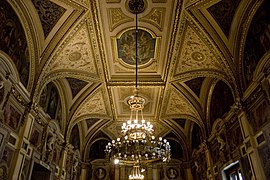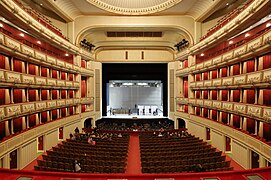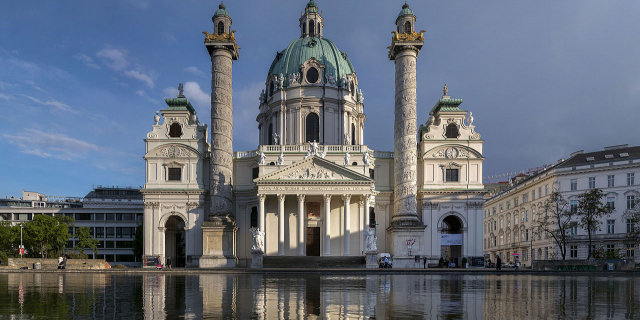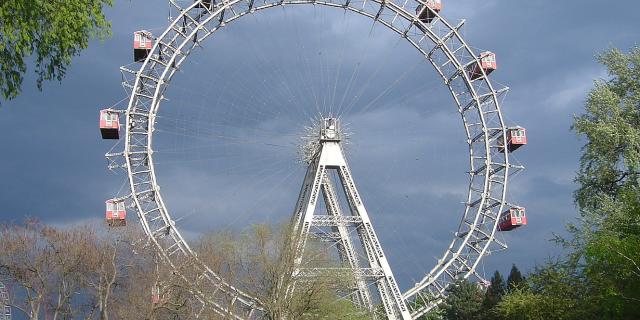Wiener Staatsoper
( Vienna State Opera )
The Vienna State Opera (German: Wiener Staatsoper, IPA: [ˈviːnɐ ˈʃtaːtsˌʔoːpɐ]) is a historic opera house and opera company based in Vienna, Austria. The 1,709-seat Renaissance Revival venue was the first major building on the Vienna Ring Road. It was built from 1861 to 1869 following plans by August Sicard von Sicardsburg and Eduard van der Nüll, and designs by Josef Hlávka. The opera house was inaugurated as the "Vienna Court Opera" (Wiener Hofoper) in the presence of Emperor Franz Joseph I and Empress Elisabeth of Austria. It became known by its current name after the establishment of the First Austrian Republic in 1921. The Vienna State Opera is the successor of the old Vienna Court Opera (built in 1636 inside the Hofburg). The new site was chosen and the construction paid by Emperor Franz Joseph in 1861.
The members of the Vienna Philharmonic are recru...Read more
The Vienna State Opera (German: Wiener Staatsoper, IPA: [ˈviːnɐ ˈʃtaːtsˌʔoːpɐ]) is a historic opera house and opera company based in Vienna, Austria. The 1,709-seat Renaissance Revival venue was the first major building on the Vienna Ring Road. It was built from 1861 to 1869 following plans by August Sicard von Sicardsburg and Eduard van der Nüll, and designs by Josef Hlávka. The opera house was inaugurated as the "Vienna Court Opera" (Wiener Hofoper) in the presence of Emperor Franz Joseph I and Empress Elisabeth of Austria. It became known by its current name after the establishment of the First Austrian Republic in 1921. The Vienna State Opera is the successor of the old Vienna Court Opera (built in 1636 inside the Hofburg). The new site was chosen and the construction paid by Emperor Franz Joseph in 1861.
The members of the Vienna Philharmonic are recruited from the Vienna State Opera's orchestra. The building is also the home of the Vienna State Ballet, and it hosts the annual Vienna Opera Ball during the carnival season.
 Vienna State Opera House under construction, 1865History of the building
Construction
Vienna State Opera House under construction, 1865History of the building
Construction
The opera house was the first major building on the Vienna Ringstrasse commissioned by the Viennese "city expansion fund". Work commenced on the house in 1861 and was completed in 1869, following plans drawn up by architects August Sicard von Sicardsburg and Eduard van der Nüll. It was built in the Neo-Renaissance style by the renowned Czech architect and contractor Josef Hlávka.
 Play bill for the opening performance of the new Opernhaus, announcing the opening performance of Don Giovanni on 25 May 1869
Play bill for the opening performance of the new Opernhaus, announcing the opening performance of Don Giovanni on 25 May 1869 Coeval watercolour painting of the opening performance (Kunsthistorisches Museum)
Coeval watercolour painting of the opening performance (Kunsthistorisches Museum)The Ministry of the Interior had commissioned a number of reports into the availability of certain building materials, with the result that stones long not seen in Vienna were used, such as Wöllersdorfer Stein, for plinths and free-standing, simply-divided buttresses, the famously hard stone from Kaisersteinbruch, whose colour was more appropriate than that of Kelheimerstein, for more lushly decorated parts. The somewhat coarser-grained Kelheimerstein (also known as Solnhof Plattenstein) was intended as the main stone to be used in the building of the opera house, but the necessary quantity was not deliverable. Breitenbrunner stone was suggested as a substitute for the Kelheimer stone, and stone from Jois was used as a cheaper alternative to the Kaiserstein. The staircases were constructed from polished Kaiserstein, while most of the rest of the interior was decorated with varieties of marble.
 The Hofoper, c. 1898
The Hofoper, c. 1898The decision was made to use dimension stone for the exterior of the building. Due to the monumental demand for stone, stone from Sóskút, widely used in Budapest, was also used. Three Viennese masonry companies were employed to supply enough masonry labour: Eduard Hauser (still in existence today), Anton Wasserburger and Moritz Pranter. The foundation stone was laid on 20 May 1863.
Public responseThe building was, however, not very popular with the public. On the one hand, it did not seem as grand as the Heinrichshof, a private residence which was destroyed in World War II (and replaced in 1955 by the Opernringhof). Moreover, because the level of Ringstraße was raised by a metre in front of the opera house after its construction had begun, the latter was likened to "a sunken treasure chest" and, in analogy to the military disaster of 1866 (the Battle of Königgrätz), was deprecatingly referred to as "the 'Königgrätz' of architecture". Eduard van der Nüll committed suicide, and barely ten weeks later Sicardsburg died from tuberculosis so neither architect saw the completion of the building. The opening premiere was Don Giovanni, by Mozart, on 25 May 1869. Emperor Franz Josef and Empress Elisabeth (Sissi) were present.
WW II bombing and redesign Play bill of the last performance in the old building: Götterdämmerung, 30 June 1944
Play bill of the last performance in the old building: Götterdämmerung, 30 June 1944Towards the end of World War II, on 12 March 1945, the opera was set alight by an American bombardment.[citation needed] The auditorium and stage were destroyed by flames, as well as almost the entire décor and props for more than 120 operas with around 150,000 costumes. The front section, which had been walled off as a precaution, however, remained intact including the foyer, with frescoes by Moritz von Schwind, the main stairways, the vestibule and the tea room. The State Opera was temporarily housed at the Theater an der Wien and at the Vienna Volksoper.
Lengthy discussion took place about whether the opera house should be restored to its original state on its original site, or whether it should be completely demolished and rebuilt, either on the same location or on a different site. Eventually the decision was made to rebuild the opera house as it had been, and the main restoration experts involved were Ernst Kolb (1948–1952) and Udo Illig (1953–1956).
The Austrian Federal Chancellor Leopold Figl made the decision in 1946 to have a functioning opera house again by 1949. An architectural competition was announced, which was won by Erich Boltenstern. The submissions had ranged from a complete restructuring of the auditorium to a replica of the original design; Boltenstern decided on a design similar to the original with some modernisation in keeping with the design of the 1950s. In order to achieve a good acoustic, wood was the favoured building material, at the advice of, among others, Arturo Toscanini. In addition, the number of seats in the parterre (stalls) was reduced, and the fourth gallery, which had been fitted with columns, was restructured so as not to need columns. The façade, entrance hall and the "Schwind" foyer were restored and remain in their original style.
In the meantime, the opera company, which had at first been performing in the Volksoper, had moved rehearsals and performances to Theater an der Wien, where, on 1 May 1945, after the liberation and re-independence of Austria from the Nazis, the first performances were given. In 1947, the company went on tour to London.
Due to the appalling conditions at Theater an der Wien, the opera company leadership tried to raise significant quantities of money to speed up reconstruction of the original opera house. Many private donations were made, as well as donations of building material from the Soviets, who were very interested in the rebuilding of the opera. The mayor of Vienna had receptacles placed in many sites around Vienna for people to donate coins only. In this way, everyone in Vienna could say they had participated in the reconstruction and feel pride in considering themselves part owners.
However, in 1949, there was only a temporary roof on the Staatsoper, as construction work continued. It was not until 5 November 1955, after the Austrian State Treaty, that the Staatsoper could be reopened with a performance of Beethoven's Fidelio, conducted by Karl Böhm.[1] The American Secretary of State, John Foster Dulles, was present. The state broadcaster ORF used the occasion to make its first live broadcast, at a time when there were only c. 800 televiewers in the whole of Austria. The new auditorium had a reduced capacity of about 2,276, including 567 standing room places.[2] The ensemble, which had remained unified until the opening, crumbled in the following years, and slowly an international ensemble formed.
History of the Company After the Second World WarIn 1945, the Wiener Mozart-Ensemble was formed, which put on world-renowned guest performances and became known particularly for its singing and playing culture. The Austrian conductor Josef Krips was the founder and mentor, who had only survived the Nazi era (given his Jewish heritage) thanks to luck and help from colleagues. At the end of the war, Krips started the renovation of the Staatoper, and was able to implement his aesthetic principles, including the departure from the Romantic Mozart ideal with a voluminous orchestral sound. Instead, qualities more associated with chamber music were featured, as well as a clearer, lighter sound, which would later come to be known as "typically Viennese". Singers who worked with Krips during this time were Erich Kunz, Elisabeth Schwarzkopf and Wilma Lipp, among others.
As early as 1947, the Mozart-Ensemble was playing guest performances at the Royal Opera House in London, with Mozart's Don Giovanni. Richard Tauber, who had fled from the Nazis, sang Don Ottavio; three months later he died, and was remembered for singing with "half a lung" in order to fulfil his dream, many other artists became associated with the Mozart-Ensemble, for example Karl Böhm, but their role was still greatly peripheral, in a straightforward or assisting role. This was the beginning of Krips' worldwide career, which would take him to the most prominent houses in the world. Until his death in 1974, Krips was regarded as one of the most important Maestri (conductors/music directors) of the Staatsoper.
On 1 July 1998, a historical broadcast took place, as Austria undertook its first presidency of the European Union. Fidelio was broadcast live from the Vienna State Opera to the 15 capital cities of the EU.









































Add new comment